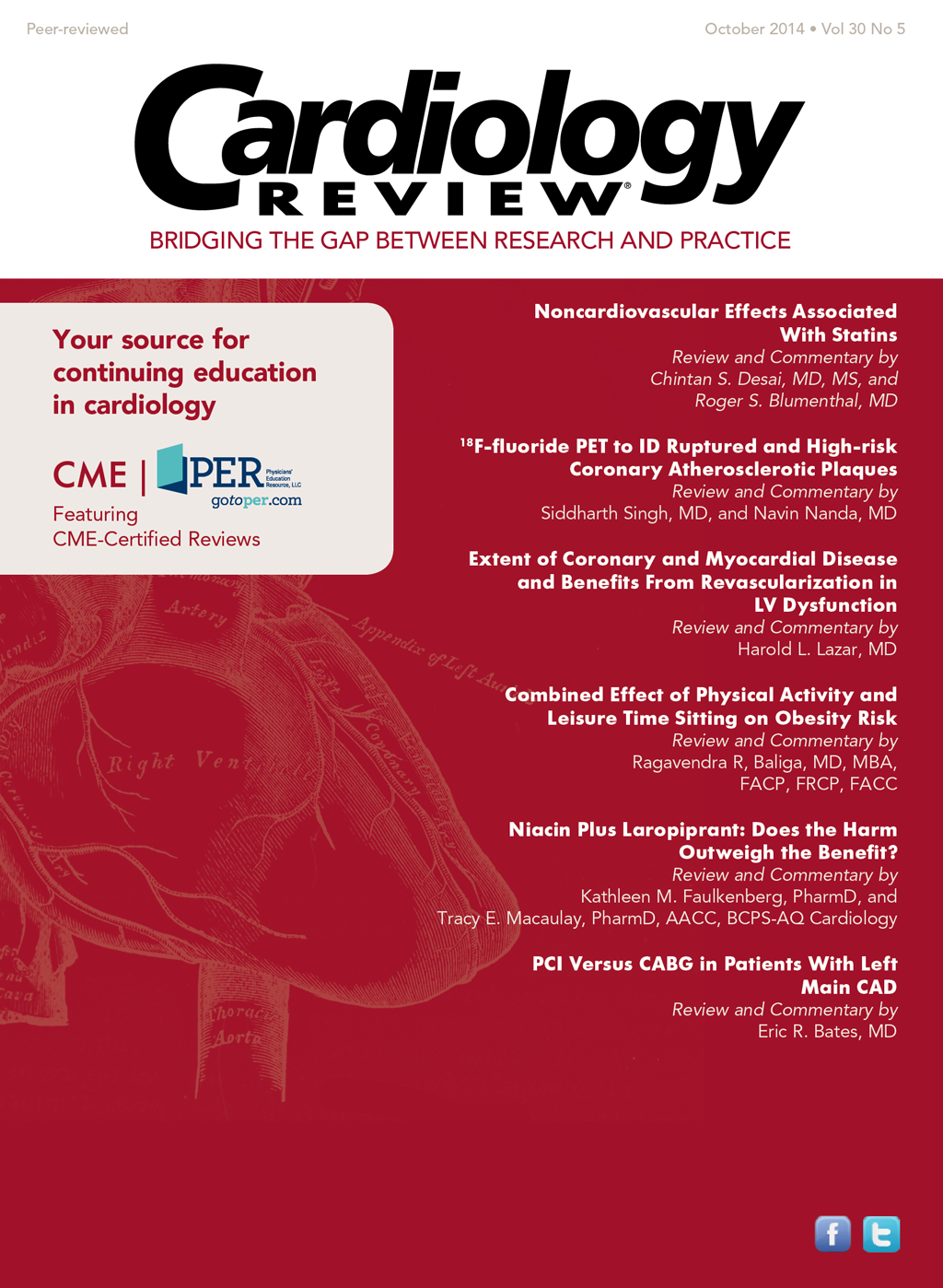Publication
Article
Cardiology Review® Online
PCI Versus CABG in Patients with Left Main CAD
Author(s):
Choosing the revascularization strategy is a complex decision for the Heart Team and patient.
Review
Morice M-C, Serruys PW, Kappetein AP, et al. Five-year outcomes in patients with left main disease treated with either percutaneous coronary intervention or coronary artery bypass grafting in the Synergy Between Percutaneous Coronary Intervention with Taxus and Cardiac Surgery trial. Circulation. 2014;129:2388-2394.
C
oronary artery bypass graft surgery (CABG) has been the standard of care for patients with significant left main coronary artery disease (CAD) since a survival advantage was demonstrated 4 decades ago in randomized clinical trials. Additionally, CABG has been a more attractive revascularization option than percutaneous coronary intervention (PCI) because up to 80% of left main CAD involves the distal bifurcation into the left anterior descending and circumflex coronary arteries, where a higher risk of adverse cardiac events has been documented. Up to 80% of patients also have multivessel CAD, where CABG offers an additional survival advantage. More recently, however, PCI has earned a Class IIa recommendation in the American College of Cardiology/American Heart Association practice guidelines for selected patients with unprotected left main CAD. The Synergy Between PCI with Taxus and Cardiac Surgery (SYNTAX) trial had a major impact on
Study Details
The SYNTAX investigators screened patients with left main or 3-vessel CAD and no prior history of CABG or PCI using a heart team conference approach that included a cardiac surgeon and an interventional cardiologist.
1
Patients were enrolled if they could be offered equivalent revascularization by CABG or paclitaxel drug-eluting stent (DES) implantation. A SYNTAX score to grade anatomic complexity (low risk, ≤22; intermediate risk, 23-32; high risk, ≥33) was developed as part of the analytic plan. The primary end point was the 1-year rate of major adverse cardiac and cerebrovascular events (MACCE), defined as the composite of death, myocardial infarction (MI), stroke, and repeat revascularization. Between 2005 and 2007, 1800 patients with left main or 3-vessel CAD were randomized to CABG (n = 897) or PCI (n = 903). MACCE was significantly lower in the CABG group (12.4% vs 17.8%; P = .002), mostly due to a lower rate of repeat revascularization (5.9% vs 13.5%; P<.001). MI rates were similar, but stroke was more likely to occur with CABG (2.2% vs 0.6%; P = .003).
However, at 5 years, compared with PCI, CABG was associated with lower MACCE (26.9% vs 37.3; P<.0001), MI (3.8% vs 9.7%; P<.0001), and repeat revascularization (13.7% vs 25.9%; P<.0001) rates.
2
All-cause death (11.4% vs 13.9%; P = .10) and stroke (3.7% vs 2.4%; P = .09) were not significantly different. MACCE was not significantly lower with CABG in patients with low SYNTAX scores (28.6 vs 32.1%; P = .43), but was significantly lower with CABG in patients with intermediate (25.8% vs 36.0%; P = .008) or high SYNTAX scores (26.8% vs 44.0%; P<.0001).
Patients with left main CAD (n = 705) were stratified for randomization and prespecified subgroup analysis.
3
In the left main CAD subgroup, 1-year MACCE was similar for CABG and PCI (13.7% vs 15.8%; P = .44), but stroke rates were higher with CABG (2.7% vs 0.3%; P = .009), whereas repeat revascularization rates were lower (6.5% vs 11.8%; P = .02). Those with high SYNTAX scores had worse outcomes with PCI than those with low or intermediate SYNTAX scores. At 5-year follow-up, there was no difference for CABG compared with PCI in MACCE (31.0% vs 36.9%; P = .12), death (14.6% vs 12.8%; P = .53), or MI (4.8% vs 8.2%; P = .10) rates.
4
CABG was associated with a higher rate of stroke (4.3% vs 1.5%; P = .03) and a lower risk for repeat revascularization (15.5% vs 26.7%; P<.001). MACCE rates were comparable in patients with lower and intermediate SYNTAX scores. In those with high SYNTAX score, CABG was associated with numerically lower mortality (14.1% vs 20.9%, P = .11), less repeat revascularization (11.6% vs 34.1%; P<.001), but higher risk of stroke (4.9% vs 1.6%; P = .13).






